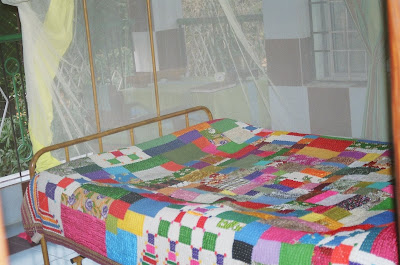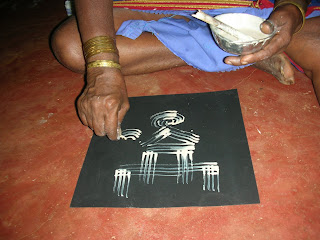A village in Honnavar ,Gersoppa is 24 KM from Honnavar The place is mentioned in several inscriptions as Naggarbastikeri,or just Nagare. It is on the other side of the river Sharavathi.On the bamk is the present village and on the other the old town with its historical remains.This was the capital town of the Salwa kings of Gersoppa from the early 14th century and continued to be so till 1606
There is a small boat taking people across from the river bank. My mother and i waited this side of the river bank thinking about how to reach Nagar basthi.We enquired people about the duration of time to reach basthi They are not sure ..It is varied 30 min to one hour .I was not in a mood to trek that far as i was tired due to my previous days beach trekking
.Sharavathi river made her way in the middle of thick forest. My mother told me that Sharavthi is called Gersoppe Hole from the local people.
I was there to just to find out what is left in nagar basthi. I still have the faint memories of my trip to Nagarbasti during my school days.. Thick forest.. Ruins… carpet of dry leaves,, no traces human habitat and a story of robbers unseating of one of the thirathankaras idol in the hope of finding treasure. .
With all these memories I am visiting this place again with my mother after 28years !!
We reached a place where we could see the ruins of jain establishments and beautiful Chaturmuhkha basadi in the middle of the forest.
The quietness …the ruins …and the forest took me into different era …I could feel in the air …..that historical moments….!!!!!
I could hear the voice in that silent forest.....I could hear the voice in that silent forest….
…….We must deal with her, most carefully and diplomatically. We must be courteous, polite and diplomatic to win her to our side”
Chennabhairadevi, the Queen of Gersoppa
Chennabhairadevi -Raina- Da-Pimenta or "Pepper Queen"
• Chennabhairadevi belonged to Tuluva-Salva lineage wherein the ruler or
a noble was succeeded by his sister's son or "aliyasantana“
• Chennabhairadevi, who had the longest rule for fifty four years, showed
rare statesmanship, bravery and shone as patron of all religions and sects.
• Akalanka, the Jain scholar and Bhattakalaka, the renowned grammarian
were protégés of Gersoppa queen.
• Inscriptions call Chennabhairadevi, as ruler of Haiva, Tuluva and Konkan
areas. These roughly comprised of North and South Kanaras, southern
region of Goa and Malbar
• This entire belt was known as pepper country, where the spices grew
abundantly in the virgin forests, which were in great demand in Europe.
Actually Chennabhairadevi was known as Raina- Da-Pimenta or "Pepper
Queen".
• Though the Vijayanagara empire was on the decline, the queen called
herself a subordinate of Vijayanagar rulers. She was always busy checking
the advances of Portuguese. At the same time she had to be ever alert
with the rulers of the adjoining Keladi kingdom and Bilgi chiefs,. They
always tried to grab the harbors and trade.
• The efforts of Keladi Nayaka and Bilgi chiefs continued to pull her down.
They jointly attacked Gersoppa, completely defeating the brave queen.
Gersoppa thus became part of Keladi kingdom. The ageing queen was
taken a prisoner and died in a prison in Keladi.
• Thus ended the rule of a brave, kind, tolerant and benevolent queen who
perhaps had the longest reign as a woman ruler in Indian history.
Chaturmukha Basadi is the chief one, a beautiful structure built in the Vijaynagar style with four
entrances from four directions which lead to the garbhagriha, which has four separate sets of
idols facing the four entrances. The temple is built in grey granite.
The four idols in the
garbhagriha are of the Tirthankaras seated in the padmasana posture.
You may also hear untold stories in the air........!





























































